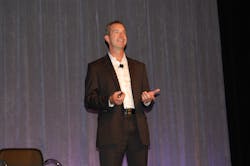To truly give trucking companies the ability to manage their fleets in real time, telematics systems and related technology must move away from generating and delivering raw data to instead focusing on how to provide more narrower-focused sets of information so fleet managers and drivers alike can make faster, wiser, and more profitable decisions.
That’s the belief shared by a range of experts during two presentations at the 2014 Great American Trucking Show (GATS) held in Dallas, TX, last week.
Rick Glasmann, VP-OEM strategy, sales, and marketing for Omnitracs, said that 90% of the data being generated around commercial trucking operations is simply “noise,” while the remaining 10% contains “mission-critical” items.
What telematics technology must do is take all of that data and “filter it” so fleets can manage by the exceptions.
“It’s all about making more informed decisions; about getting the right information at the right time,” Glasmann explained. “For example, data that is ‘red flagged’ gets looked at on a daily basis; ‘yellow flags’ at some point down the line; and ‘green’ data means you are good to go so it does not need looking at.”
One issue he believes that keeps slowing this “data-to-information” shift is the continued insistence on maintaining “proprietary data” among OEMs, suppliers, and fleets alike.
“At some point more of this data needs to be shared in order to boost analytical capability; it can’t all be kept under lock and key,” Glasmann stressed. “Integrating data allows for far better analysis, such as [vehicle] prognostics; where we look at data trends, compare that to degraded performance such as fuel economy; compare that to historical data; and so swap out components before a breakdown occurs.”A panel discussion dubbed “The Connected Fleet” expanded on Glasmann’s theme, with Rich Ferguson – senior VP-aftermarket and soft products for The Volvo Group – noting that fleets need real-time information not just about the vehicle, but about its load and the driver as well.
[Left to right: Kennon Guglielmo, CTO, Enovation Controls; Scott Newhouse, Peterbilt; Rich Ferguson, The Volvo Group; Jim Coffren, Hirschbach Motor Lines.]
“We need to look at it as a ‘connected vehicle ecosystem’ that allows fleet managers to move from a reactive to proactive decision-making stance,” he added.
That’s why Scott Newhouse, director of product planning and strategy for Peterbilt Motors Co., said future “connectivity” with customers will be more about vehicle uptime and productivity than merely repair work.
Jim Coffren, VP-maintenance for Hirschbach Motor Lines, picked up on that theme by stressing that it’s part of providing what he called “contextual data” to fleet managers – data provided in terms of how it impacts trucking operations as a whole.
“We need to use data to know where the opportunities are,” he noted – pointing out that at many fleets 15% to 20% of their vehicles may be under-performing in terms of fuel economy, maintenance costs, etc., yet the fleets don’t know about it.
“The key is to make decisions that take care of not just the vehicle, but the load and the driver at the same time,” Coffren stressed. “A truck down for repairs means a driver doesn’t get a paycheck and the customer doesn’t get their load on time. That’s why ‘contextual data’ is so important; we need data on a breakdown in real-time because we’ve got 98% on-time delivery requirements.”
About the Author
Sean Kilcarr
Editor in Chief
Sean Kilcarr is a former longtime FleetOwner senior editor who wrote for the publication from 2000 to 2018. He served as editor-in-chief from 2017 to 2018.

